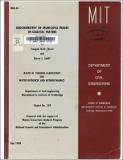| dc.description.abstract | Introduction: As we mine primary ores at an increasing rate, as we synthesize more exotic compounds in greater quantities, as we produce expanding heaps of waste, as we reroute rivers through our faucets, we are becoming an important and sometimes a dominant agent of the global geochemical cycle. Disposal of municipal wastes is a key process in this anthropic part of the elemental fluxes, for a municipal sewage system is a giant funnel which brings in one place at each instant the end products of much of the dispersed consumptive activities of a whole community. In addition to its net contribution to the flux of natural elements and to the exotic nature of some of its constituents, it is this increasingly prevalent concentration process that gives human waste its unique position in the elemental economy of the planet. Lest we should be too conceited, even in our ability to pollute, the laws of nature must have their way. Ultimately all elements in the sea must be controlled by the biogeochemical processes that govern their oceanic cycles. The question posed by the practice of municipal waste disposal into the ocean is then principally one of rates: are natural biogeochemical processes in the oceans fast enough to "assimilate" human waste? Are the dispersive and degradative mechanisms suitably rapid to maintain the concentration of all potential toxicants at acceptably low concentrations? Are the ecological processes sufficiently dynamic to buffer the impact of concentrated elemental loads, to adapt to the presence of new chemical constituents? These questions can be asked on various geographical scales, from local to global, and on various time scales from hours to centuries. On the whole we are still quite ignorant of the functioning of oceanic systems; we do not comprehend sufficiently many of the processes that govern the fate of waste constituents; we cannot answer some of our basic questions. Yet, we are in the process of learning a great deal. This chapter is an attempt at organizing some of the key known facts on the biogeochemistry of waste in coastal waters, at developing a conceptual framework for research and decision making. There are on the order of ten thousand chemical constituents in wastewaters, only about a hundred of which we know anything about. It appears that our sole hope is to develop general principles to provide, in the long run, some of the necessary answers. Municipal wastewaters are a varied lot. Although domestic sewage has a fairly uniform composition throughout the country, the industrial wastes that are often added to it do not. Metal finishing plants contribute high concentrations of some metallic compounds; chemical manufacturing processes release highly specific sets of organic constituents. In cities with combined sewers, urban storm water runoff, with its own characteristic composition, is included in the municipal sewer system. Also varied are the levels of treatment and the methods of disposal. A few cities still dispose of their raw sewage while others have added tertiary treatment to their systems. Efficient outfalls with diffusers are used in some places to carry the effluents far offshore and dilute it effectively; in many others, wastewaters are released close to shore with inefficient mixing. Barge dumping of sludge is prevalent in many areas. Just as diverse are the hydrodynamic and hydrological characteristics of the receiving waters: confined bays, harbors and estuaries in some places, open coastline in others; rapidly increasing water depth offshore on one coast, extended continental margins on the other. Current and tidal regimes which vary with time and location result in widely different waste dilution and transport processes. All this variability in effluent composition, in initial mixing, and in short and long term transport processes affects to a large degree the fate of the waste constituents. At this point, it would be a hopeless task to attempt to cover all combinations of these, to consider the problem of disposal of all types of municipal wastes in all types of receiving waters. By a fortune of sorts, one is quite limited by the available information. We have made no attempt in this chapter to be exhaustive; rather we have concentrated on these systems for which extensive data were available. In this way it is hoped that a self coherent picture will be obtained from which one may draw information to be applied to other situations. However, major caveats are clearly in order: i) the available information concerns almost exclusively the major urban centers; in some instances it may be of little relevance to small or medium size communities; ii) the Southern California Bight--which is by no means typical--has been the locus of the most intensive and extensive research efforts on the geochemistry of waste. As such it provided the data for much of this chapter. (For convenient reference on names and locations, a map of the major Southern California outfalls is provided in Fig. 0-1). One should keep in mind these demographic and geographical biases. | en_US |
